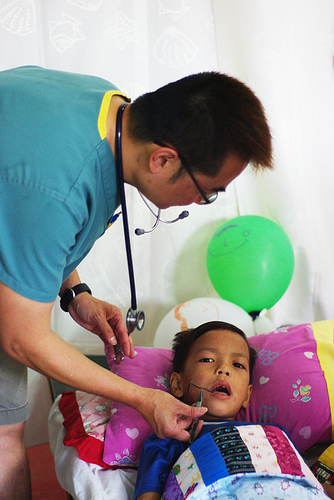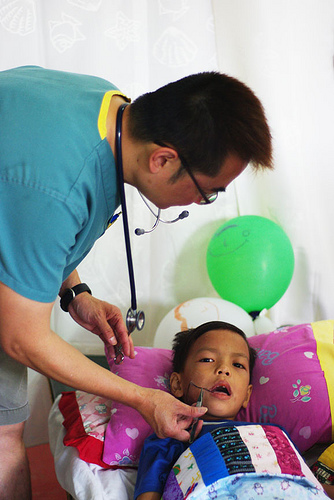
The Children’s Survival Center is the building used as a ward for the Rotaplast patients. It is divided by curtains into a pre-op and a post-op area, with a central nursing station. It’s a busy, noisy area with parents and patients using the small green army-type cots both before and after surgery. With fifteen pre-op families and fifteen post-op families on average, it is not always conducive to rest; but as these families are so grateful to have the opportunity to receive these cleft lip and palate repairs, there’s a remarkably upbeat atmosphere.
In the ward area, the PACU Assistant, the Patient Ward Coordinators, and the transporters all have important jobs. Vasanth and Bent (Ward Coordinators) and Bob (Transfer Coordinator) sometimes attend with the PACU assistant, Marnee, when the pediatrician is checking the patients. The pediatrician, Collin, checks the children in the morning for fever, etc., and establishes that they have not had anything to eat or drink. He then clears the patient to be taken to the Operating Room.
When the surgeons ask for their patients, the transporters bring them to the OR area. The route from the ward goes all the way up the side of the hospital, in through a side door, then up the elevator, or via a long ramp to the operating room area on the third floor.
When the patients are seated outside the OR rooms, the dentist, Natividad, and the orthodontist, Rosario, call them to check if there are any dental requirements; when the OR room is ready the surgeon will come out and ask for the patient in order to check them again, before taking them to the OR. When the surgery is finished, the patient is taken to the recovery area, and, when stable, the Recovery nurses (Joanne and Margaret) ask the transporters to take them back down to the ward. Two hospital employees help with the transport, but a Rotaplast team member always carries the files. The child is then assigned a cot in the ward. The local Cebu nurses, headed by Henry, take over daily care from there.
There is quite a bit of overlapping of roles, as sometimes the patients need to be kept occupied. For example, Bent, a major Rotarian fundraiser for this Mission, spent time printing photos for the kids, and ward volunteers were often seen blowing up balloons, or helping the kids color pictures. The assistant mission director, Rosalie, taught the older girls how to make braided bracelets from thread. It may not be your normal hospital scene, but it works well. Several of the kids became really attached to the Rotaplast team members, and on Saturday’s final post-op final check day, there were many teary, but happy, scenes.




